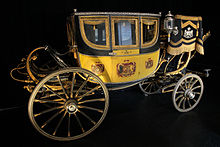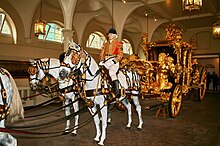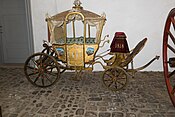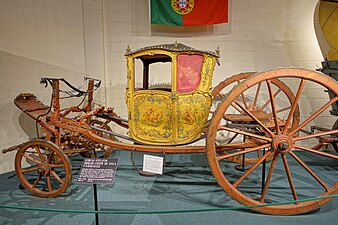

A state coach, also known as a gala coach, is a highly decorative ceremonial coach used in Europe by a monarch or head of state on state occasions. A four-wheeled vehicle for four passengers, it may be drawn at a walk by six or more horses with postilions, or be driven by two or more horses. The term is also used to indicate a formal town coach used by nobility and the wealthy for formal occasions, drawn by a pair of matching horses.
A state chariot, also called a gala chariot or dress chariot, is an elaborately decorated four-wheeled vehicle for two passengers for ceremonial occasions; often the front panel is replaced by a glass panel or windscreen. The word chariot was used in England, and coupé in France.
Overview
The first state coach was built in the mid-1500s by Walter Rippon for the State Opening of Parliament, and most had been built by 1840. State coaches are still used for royal weddings and other state ceremonial events.
State coaches were built by the best coachbuilders with excellent craftsmanship and the finest finishes. Most state coaches have large glass windows so that their passengers can be seen by spectators. The interiors are trimmed in silks and the exteriors decorated with elaborate paintings, figures, coats of arms, gilt-work, and hammercloths. The coachman and footmen wear state livery and the horses are harnessed with ornate state harness.

The coachmen, footmen, and postilions on state coaches wore ornate livery to match the grandeur of the coaches themselves. ... dressed in appropriately ornate livery coats, richly embellished with gold cords and strappings, worn with silk knee breeches, silk stockings, buckled shoes, and a cocked hat.
— Thomas Ryder, Fashion on Wheels
Many state coaches were constructed to be convertible. They can be driven by a coachman from a driver's seat in the front, usually covered by an elaborate hammercloth, or the seat can be removed and the carriage is guided by postilion riders and outriders. A carriage arranged for postilion may have "à la Daumont" appended to its name. "Daumont" is a corruption of the French d'Aumont from the 8th Duke of Aumont who preferred this manner of travel.
Early state coaches in England were drawn by cream-colored horses of Hanoverian blood. In the early 1920s they were replaced by black horses. Now, teams of grey horses are used for the Sovereign, and bay horses are used for other passengers.
Another type of state coach is the cardinal's coach, which was painted red and used by cardinals.
List of state coaches
| Image | Name | Built | State | Location | Notes |
|---|---|---|---|---|---|

|
Bridal Coach | 1560-1561 | Germany | Veste Coburg Coburg |
Golden bridal coach of Dorothea of Denmark reused for the 1599 wedding of her daughter Margaret with Duke John Casimir |

|
Bridal Coach | 1586 | Germany | Veste Coburg Coburg |
Golden bridal coach built for the 1586 wedding of Anna of Saxony with Duke John Casimir |

|
Golden Coach for the Imperial Embassy to Pope Urban VIII | 1638 | Czech Republic | Český Krumlov Castle Český Krumlov |
Built in Rome for Johan Anton I von Eggenberg, Imperial ambassador to the Holy See |

|
State Coach of Maria Francisca of Savoy, Queen of Portugal | 1666 | Portugal | National Coach Museum Lisbon |
Brought from France by Maria Francisca of Savoy on the occasion of her wedding to Peter II of Portugal |

|
Swedish Coronation Coach | 1696-1699, 1751 | Sweden | Livrustkammaren Stockholm |
Built in Paris for Charles XI, refurbished in 1751 |

|
Speaker's State Coach | 1698 | United Kingdom | Palace of Westminster London |
Built for William III |

|
State Coach of Maria Anna of Austria, Queen of Portugal | 1708 | Portugal | National Coach Museum Lisbon |
Given by the Holy Roman Emperor to his sister Maria Anna of Austria on the occasion of her marriage to John V of Portugal |

|
State Coach of the Oceans | 1716 | Portugal | National Coach Museum Lisbon |
Built in Rome for the Portuguese ambassador to the Holy See |

|
State Coach of the Coronation of Lisbon | 1716 | Portugal | National Coach Museum Lisbon |
Built in Rome for the Portuguese ambassador to the Holy See |

|
State Coach of the Ambassador | 1716 | Portugal | National Coach Museum Lisbon |
Built in Rome for the Portuguese ambassador to the Holy See |

|
State Coach of King John V | 1720 (c.) | Portugal | National Coach Museum Lisbon |
Built in Portugal for John V of Portugal |

|
Imperial Coach | 1735 | Austria | Imperial Carriage Museum Vienna |
Built for Charles VI |

|
Coronation coach of Emperor Charles VII | 1742 | Germany | Marstallmuseum Nymphenburg Munich |
Built for Charles VII |

|
Lord Mayor of London's State Coach | 1757 | United Kingdom | Museum of London London |
Built by Joseph Berry |

|
Gold State Coach | 1762 | United Kingdom | Royal Mews London |
Built for George III |

|
The Crown Prince's State Coach | 1763-68 | Sweden | Livrustkammaren Stockholm |
Built for crown prince Gustav |

|
The Queen's Brussels State Coach | 1780 (c.) | Sweden | Livrustkammaren Stockholm |
Built by Simons in Brussels for Queen Sophia Magdalena of Sweden |

|
Coronation coach of King Maximilian I Joseph | 1806 | Germany | Marstallmuseum Nymphenburg Munich |
Built for Maximilian I Joseph |

|
'Egiziana' State Coach | 1819 | Italy | Quirinal Palace Rome |
Built in Turin after designs by Giacomo Pregliasco for Charles Felix of Sardinia |

|
State Coach for the Baptism of the Duke of Bordeaux | 1821 | France | Galerie des Carrosses Versailles |
Built for the Baptism of the Duke of Bordeaux, redecorated 1852-53 for the wedding of Napoleon III |

|
'The Crown' State Coach | 1824 | Portugal | National Coach Museum Lisbon |
Built in London for John VI |

|
Coronation Coach of Charles X | 1825 | France | Galerie des Carrosses Versailles |
Completed for the coronation of Charles X of France |

|
'Gran Gala Berlin' State Coach of Pope Leo XII | 1826 | Vatican City | Carriage Pavilion at the Vatican Museums Vatican City |
Built for Pope Leo XII, altered for Pope Gregory XVI |

|
Glass Coach | 1826 | Netherlands | Royal Stables The Hague |
Built by Simons in Brussels for William I |

|
State Coach of the Royal Crown | 1829-33 | Spain | Royal Collections Gallery Madrid |
Built in Madrid by Julián González for Ferdinand VII |

|
Scottish State Coach | 1830 | United Kingdom | Royal Mews London |
Built for Prince Adolphus |

|
Golden Coupé | 1840 | Denmark | Royal Mews and Carriage Museum, Christiansborg Palace Copenhagen |
Built for Christian VIII |

|
Coronation Coach of Pedro II of Brazil | 1841 | Brazil | Imperial Museum of Brazil Petrópolis |
Built in London for the coronation of Emperor Pedro II of Brazil |

|
Irish State Coach | 1851 | United Kingdom | Royal Mews London |
Built by Thomas Hutton, and later purchased by Queen Victoria. Replicated by Barkers in 1911 when it was destroyed by fire at their shop |

|
Napoleon III State Coach | 1852 | Belgium | Art & History Museum exhibited at Autoworld Brussels |
Built by Ehrler in Paris for Napoleon III Used at the Baptism of Louis-Napoléon, Prince Imperial |

|
State Coach 'Louise-Marie' | 1855 (c.) | Belgium | Art & History Museum exhibited at the Palace of Laeken Brussels |
Built by Jones Frères in Brussels for King Leopold I of Belgium |

|
Coronation Coach of Alexander II | 1856 | Russia | Tsarskoye Selo State Museum Saint Petersburg |
Built by Christian Tatzki in St. Petersburg for the coronation of Alexander II of Russia |

|
Emperor Maximilian's State Coach | 1864 | Mexico | Chapultepec Castle Mexico City |
Built by Cesare Scala in Milan for Maximilian I of Mexico |

|
Emperor Franz Joseph's State Coach | 1865 | Austria | Imperial Carriage Museum Vienna |
Built by Carl Marius for Emperor Franz Joseph I of Austria |

|
Queen Alexandra's State Coach | 1865 | United Kingdom | Royal Mews London |
Built as a town coach, later converted to a state coach for Queen Alexandra |

|
New dress coach of Ludwig II | 1870 | Germany | Marstallmuseum Nymphenburg Munich |
Built for Ludwig II of Bavaria |

|
Glass Coach | 1881 | United Kingdom | Royal Mews London |
Purchased by the Crown for the coronation of George V and Mary in 1911 |

|
Cotillion Coach | 1888 | Denmark | Royal Mews and Carriage Museum, Christiansborg Palace Copenhagen |
Miniature coach for Christian IX |

|
Gran Carroza de Gala | 1890 (c.) | Chile | Museo del Carmen de Maipú [es] Santiago |
Barouche built by Paris coachbuilder Million-Guiet for Chile president José Manuel Balmaceda |

|
State Coach of the French Republic | 1896 | France | National Car and Tourism Museum, Compiègne | Built for the French President on the occasion of the State visit of Czar Nicholas II |

|
Golden Coach | 1898 | Netherlands | Royal Stables The Hague |
Built by Spyker as a gift from the people of Amsterdam to Queen Wilhelmina |

|
'Cream Calèche' | 1898 | Netherlands | Royal Stables The Hague |
Built by Hermans & Co in The Hague for Queen Emma as a gift to her daughter Queen Wilhelmina |

|
State Landau | 1902 | United Kingdom | Royal Mews London |
Built by Hooper for Edward VII; drawn by 6 grey horses with three postilion riders |

|
Australian State Coach | 1988 | United Kingdom | Royal Mews London |
Built for Elizabeth II |

|
Diamond Jubilee State Coach | 2010 | United Kingdom | Royal Mews London |
Built for Elizabeth II |
Gallery
- A sampling of the variety of state coaches and chariots
-
 18th century Berlin from France
18th century Berlin from France
-
 1729 gala coupé, Royal House of Portugal
1729 gala coupé, Royal House of Portugal
See also
- Gold coach
- Canadian State Landau
- Japan state carriages (Simple Misplaced Pages, Japanese Misplaced Pages)
Notes
- Dates may be approximate, since some of the coaches took many years to complete, and others have scant records
- 'State' is current owning nation-state; historical other countries may be listed under 'Notes'
References
- ^ Smith, D.J.M. (1988). A Dictionary of Horse Drawn Vehicles. J. A. Allen & Co. Ltd. ISBN 0851314686. OL 11597864M.
- ^ Berkebile, Donald H. (1978). Carriage Terminology: An Historical Dictionary. Smithsonian Institution Scholarly Press. ISBN 9781935623434. OL 33342342M.
- ^ Mackay-Smith, Alexander; Druesedow, Jean R.; Ryder, Thomas (1984). Man and the Horse: An Illustrated History of Equestrian Apparel. Metropolitan Museum of Art. ISBN 0870994115. OL 2859979M.
- ^ Walrond, Sallie (1979). The Encyclopaedia of Driving. Country Life Books. ISBN 0600331822. OL 4175648M.
- ^ Nockolds, Harold, ed. (1977). The Coachmakers: A History of the Worshipful Company of Coachmakers and Coach Harness Makers, 1677-1977. JA Allen. ISBN 0851312705. OL 26258137M.
- "Grand Gala Berlin". Vatican Museum. Retrieved 29 July 2024.
- Manrique, Jaimie (Spring 1978). "The State Coaches of the Republic of Chile". The Carriage Journal. 15: 373–375.
- "Carruajes". Museo del Carmen de Maipú.
- "Berlinda da Casa Real" [Royal House Berlin]. National Coach Museum (Portugal) (in Portuguese). Retrieved 29 July 2024.
Further reading
- Damase, Jacques (1968). Carriages. G. P. Putnam's Sons. OL 5604950M.
| Royal state coaches of the British monarch | ||
|---|---|---|
 | ||